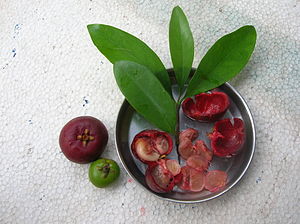Kokum
Kokum is the plum-like fruit of Garcinia indica and fruit bearing tree of the mangosteen family (Clusiaceae).

The genus Garcinia, belonging to the family Clusiaceae, includes about 200 species found in the Old World tropics, mostly in Asia and Africa. Garcinia indica is indigenous to the Western Ghats region of India located along the western coast of the country.
Garcinia indica is found in forest lands, riversides and wastelands. These plants prefer evergreen forests, but sometimes they also thrive in areas with relatively low rainfall. It is also cultivated on a small scale. It does not require irrigation, spraying of pesticides or fertilizers.
Garcinia indica is known by various names across India, including aamsol, aamsul, bindin, biran, bhirand,bhrinda, brinda, bin'na, kokum (alternate spellings kokam and cocum), katambi, looikya, sour apple, panarpuli, ratamba, thekera (in Assam) and many others.
Culinary uses
The outer cover of fruit is dried in the sun to get aamsul or kokam. It is used as a slightly sour spice in recipes from Maharashtra. Kokum yields a peculiar flavour and blackish red colour. It is a preferred substitute for tamarind in curries and other dishes from the Konkan region. It is also used in cuisine from Gujarat, where it is frequently used to add flavour and tartness to dal(lentil soup) for flavour balance, and parts of South India.